
Chicken at a wet market (Pasar Awam) in Sekinchan, Selangor, Malaysia. (Samsul Said/Bloomberg)
The global bird flu outbreak is worsening, highlighting the challenge farmers and officials face in reining in the deadly virus.
Just over 100 million poultry died or were culled due to avian influenza between the start of October and Feb. 3, according to the World Organisation for Animal Health. That's more than triple the number in the same period in the previous season, which ended with record losses from the disease.
Farms across Europe and North America have suffered severe outbreaks, and cases are also picking up in South America — including in Bolivia, which borders major chicken producer Brazil. Egg-laying hens have been among the hardest hit, boosting prices of the grocery staple and further squeezing consumers.
There have also recently been signs of the virus adapting to different animal species, including minks in Spain — sparking questions of whether the outbreak could spread to humans. The spillover needs to be "monitored closely," although a spread to people is so far rare and not sustained, according to World Health Organization Director General Tedros Adhanom Ghebreyesus.
"We need to just be vigilant to make sure that the spread in animals is contained because the more the virus circulates in animals, the higher is the risk for humans as well," Sylvie Briand, the WHO's director for epidemic and pandemic preparedness and prevention, said in a briefing with reporters on Wednesday.